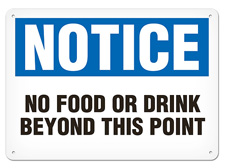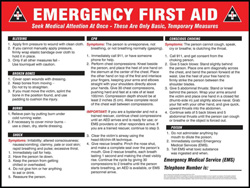



Find all of your laboratory and workplace safety supplies at Safety Emporium!
 Inflammation |
 Glossary Index |
 Inhalation |
| MSDS Topics |
Free Sites | FAQ's | Regulations | Glossary | Software | Suppliers |
| Books | Forum | Poll | Fun stuff | Quiz | Store | |
| Understand your MSDS with the MS-Demystifier | Search ALL our MSDS info | |||||
Ingestion is the act of taking something (food, medicine, liquid, poison etc.) into the body through the mouth. Synonyms include "swallowing", "taking internally", and "eating".
Do not confuse this with the term indigestion, which is an upset stomach.

Promote good chemical hygiene with laboratory signs and labels from Safety Emporium.
Avoid ingestion of hazardous chemicals (obviously!). Recognize that you can accidentally ingest toxic materials by eating/handling food in areas where toxic substances are used. Never put anything in your mouth when you are working with hazardous chemicals. Having a chemical on your hands and then eating or smoking are common ways that chemicals are accidentally ingested. Be certain to wash your hands thoroughly after working with hazardous chemicals.
Be sure that all containers are properly labeled. NEVER STORE CHEMICALS OF ANY SORT IN FOOD CONTAINERS. Do not store food and chemicals in the same refrigerator. Children can not read labels, so keep all chemicals out of the reach of children. If applying pesticides with a hose sprayer, be sure to use a backflow preventer to keep toxic materials from backing up into your drinking water line.
Always have your poison control center phone number handy with your other emergency information. NEVER induce vomiting unless specifically instructed to do so by a poison control center.
Finally, always clean up chemical spills as they can lead to unexpected ingestion. For example, children and dogs find antifreeze (ethylene glycol) to be very sweet-tasting. Ingestion of ethylene glycol can lead to liver failure and death, especially if not treated quickly.
This term usually appears on a Safety Data Sheet as a route of entry of the material into the body, in which case it would be listed under Section 11 (toxicological information). Section 11 will also describe typical symptoms of ingestion. Section 4 (first-aid measures) will describe the measures to take if the material is ingested (inducing vomiting is not necessarily the best move and, in some cases, can cause further damage). Always read the SDS before working with the material so you understand the dangers and the symptoms of exposure.

We have all kinds of first aid signs, posters and labels at Safety Emporium.
See also: emetic, inhalation, poison.
Additional definitions from Google and OneLook.
Entry last updated: Monday, January 2, 2023. This page is copyright 2000-2025 by ILPI. Unauthorized duplication or posting on other web sites is expressly prohibited. Send suggestions, comments, and new entry desires (include the URL if applicable) to us by email.
Disclaimer: The information contained herein is believed to be true and accurate, however ILPI makes no guarantees concerning the veracity of any statement. Use of any information on this page is at the reader's own risk. ILPI strongly encourages the reader to consult the appropriate local, state and federal agencies concerning the matters discussed herein.